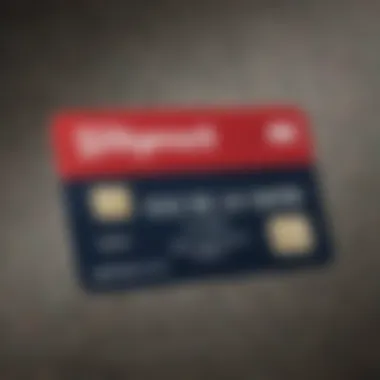Maximize Healthcare Savings with Walgreens Prescription Card


Intro
The Walgreens Prescription Card is an essential tool for individuals seeking to navigate the complexities of healthcare expenses. Many people find managing medical costs challenging, particularly when it comes to necessary prescription medications. Understanding how this card works can significantly impact your overall health management strategy.
This article will explore the various functionalities and benefits of the Walgreens Prescription Card. We will also look into the enrollment process, its interaction with insurance plans, and strategies to maximize savings. The focus will be on how this card can assist different demographics in making informed decisions about their healthcare expenses. By grasping the nuances of the Walgreens Prescription Card, you can potentially save more and manage your health more effectively.
Market Overview
Understanding the current market landscape is vital in assessing the value of the Walgreens Prescription Card. The healthcare market has seen various trends influencing the accessibility and affordability of medications.
Current Market Trends
Healthcare costs continue to rise, affecting consumers across all demographics. Many individuals are seeking options that allow them to control their expenses effectively. The Walgreens Prescription Card aims to address this need. Increased public awareness about prescription savings has led to a growing number of patients utilizing discount cards.
Economic Indicators Impacting the Market
Several economic indicators directly impact the healthcare market. These include:
- Rising healthcare costs
- Changes in insurance coverage
- Economic stability or instability affecting disposable income
These factors contribute to the increasing importance of prescription discount programs like the Walgreens Prescription Card.
Global Influences and Major Events
Global events such as the COVID-19 pandemic have shaped health care approaches. People became more conscious of healthcare expenses, leading to increased adoption of discount cards. This context serves as a backdrop for understanding how the Walgreens Prescription Card fits within the healthcare landscape.
Benefits of the Walgreens Prescription Card
The Walgreens Prescription Card provides various benefits that can significantly aid in managing healthcare expenses. Some of the notable advantages include:
- Discounted prices on prescription medications
- Accessibility at numerous Walgreens locations
- Potential integration with other healthcare programs
Tips for Maximizing Savings
To fully leverage your Walgreens Prescription Card, consider these tips:
- Compare prices at different pharmacies
- Always inquire about potential discounts at the point of sale
- Combine the card with available insurance plans for even more savings
Enrollment Process
Enrolling in the Walgreens Prescription Card program is straightforward. Generally, you can sign up online or in-store. Make sure to gather your insurance and personal information to facilitate the process.
Finale
In summary, the Walgreens Prescription Card is a practical option for individuals looking to reduce their healthcare expenses. Understanding its benefits, enrollment process, and strategies for maximizing savings is crucial for effective health management. This knowledge empowers you to make informed decisions about your healthcare spending.
Prologue to the Walgreens Prescription Card
The Walgreens Prescription Card is designed to assist individuals in navigating the often complex world of healthcare costs. As prescription drug prices continue to fluctuate, consumers are seeking ways to manage their expenses more efficiently. This section elaborates on the card's significant role within a broader healthcare strategy. It focuses on how the card offers direct savings, enhances access to necessary medications, and streamlines the reimbursement process.
Definition and Purpose
The Walgreens Prescription Card functions as a discount card that provides users with lower prices on prescription medications at Walgreens pharmacies. Its primary purpose is to alleviate the financial burden often associated with obtaining necessary medications. Unlike insurance, which can sometimes be limited in coverage or complicated by high premiums, this card allows for immediate savings on a wide variety of drugs. Users can present the card at the pharmacy to receive reduced prices, making medication more accessible to those without comprehensive insurance.
Furthermore, the card serves as an important tool for those managing chronic conditions who may require multiple prescriptions regularly. For these individuals, even small reductions in cost can add up significantly over time, thus improving their overall financial health.


Overview of Walgreens as a Pharmacy Provider
Walgreens has established itself as a prominent player in the pharmacy sector, with thousands of locations across the United States. The company is known for its commitment to serving the healthcare needs of communities. Walgreens not only provides a range of prescription medications but also offers wellness services, health consultations, and preventative care programs.
This wide array of services positions Walgreens as not just a pharmacy but a healthcare destination. The brand has consistently expanded its offerings to include health screenings and immunizations, which further entrench its importance in the healthcare landscape. With a robust infrastructure and a focus on customer service, Walgreens plays a crucial role in helping individuals maintain their health and manage their medication needs effectively.
"The Walgreens Prescription Card is not just a tool for savings; it symbolizes a commitment to accessible healthcare for all individuals."
In this context, the Walgreens Prescription Card emerges as an integral part of a user’s approach to managing healthcare expenses. Patients can not only benefit from the immediate cost savings but also leverage Walgreens’ extensive network for their overall health management.
How the Walgreens Prescription Card Works
The Walgreens Prescription Card is designed to optimize the experience for consumers in managing their healthcare expenses. It allows for seamless access to discounts and savings on prescriptions, driving its importance in modern healthcare. In this section, we will discuss how this card operates, including who is eligible, how to enroll, and how to use it effectively at Walgreens pharmacies.
Eligibility Requirements
To qualify for the Walgreens Prescription Card, individuals typically need to meet certain criteria. It is essential to note that this card is available to everyone, including those without insurance. Some of the key eligibility points include:
- No age restrictions: Anyone at any age can apply for the card.
- Residency: Must be a resident of the United States to claim benefits.
- Identification: Basic personal information will be required, including name and address.
In general, the program aims to accommodate a broad demographic. This ensures that both insured and uninsured individuals can access discounted medications, making it a valuable resource in health management.
Enrollment Process
The enrollment process for the Walgreens Prescription Card is designed to be straightforward. Here’s a simple guide on how to get started:
- Visit the Walgreens website or go to a local Walgreens store.
- Fill out the application form with necessary personal details. This includes your name and contact information.
- Accept terms and conditions. Understanding the guidelines is important for making the most of the benefits.
- Receive your card. Once your information is processed, you will get your card via mail or directly at the store.
This process is typically quick and requires minimal documentation, making it accessible for anyone seeking cost-effective options for their prescriptions.
Usage at Walgreens Pharmacies
Once you have your Walgreens Prescription Card, using it at Walgreens pharmacies is uncomplicated. Here are the steps to utilize the card effectively:
- Present your card: When purchasing any prescription medication, show your Walgreens Prescription Card to the pharmacist.
- Discount application: The pharmacist will apply the appropriate discounts at the time of sale, based on the medication and associated costs.
- Check your receipt: After the transaction, verify the final price to ensure all discounts have been appropriately applied.
This streamlined process at Walgreens not only saves time but also provides the immediate financial benefits that the card promises. Patients can leave the pharmacy assured that they have received optimal pricing for their necessary medications.
In summary, understanding how the Walgreens Prescription Card works is crucial for maximizing its benefits. This card simplifies the process of obtaining necessary medications while alleviating financial burdens.
Financial Benefits of Using the Card
The Walgreens Prescription Card provides significant financial advantages for users. This section discusses these benefits, emphasizing how this card can alleviate some of the financial burdens associated with prescription medications. It also examines the broader implications on health management and overall cost efficiency.
Discount Opportunities on Prescription Drugs
One of the most notable aspects of the Walgreens Prescription Card is the potential for substantial discounts on prescription drugs. Users can save a considerable amount compared to standard retail pricing. This benefit is especially important for individuals without insurance or those who may not wish to use their insurance for every prescription. The discounts provided can reach up to 80% on some medications, depending on the drug and the specific offer at Walgreens.
These discounts allow users to better manage their monthly healthcare expenses. By presenting the prescription card at the time of purchase, customers can access special pricing that is not available without the card. This aspect can make medications more affordable for many people, serving as a pivotal tool for health management.
Comparison with Insurance Plans
Advantages over standard insurance
The Walgreens Prescription Card can be more advantageous than standard insurance in many cases. First, there is often no need for a copay or deductible when using the card. This means that users can receive their medications at lower prices without having to meet a certain insurance requirement. Additionally, the Walgreens Prescription Card can provide access to discounts on medications that may not be covered by certain insurance plans.


This flexibility is a significant characteristic for those who may need specific medications not included in their insurance formulary. Thus, having the Walgreens Prescription Card can be a more popular choice among consumers who prioritize immediate savings without the complexities of insurance coverage.
Limitations to consider
On the other hand, the Walgreens Prescription Card has limitations. Not all medications qualify for the discounts, which can lead to frustration for consumers who rely on specific treatments. Furthermore, the card does not cover the entire spectrum of healthcare expenses, leaving out many services that traditional insurance would typically cover.
It's crucial for potential users to understand that while this card offers impressive savings on prescriptions, it should not be viewed as a complete substitute for health insurance. Users must weigh the pros and cons, considering their individual healthcare needs and financial situations. Thus, comprehending these limitations allows users to make informed choices about their health management.
Cost-Saving Strategies
To maximize the benefits of the Walgreens Prescription Card, users can adopt various cost-saving strategies. Shopping for generic options is one effective approach. Patients should always ask their healthcare provider about lower-cost alternatives when obtaining prescriptions. Additionally, being aware of ongoing Walgreens promotions can lead to further savings, as seasonal offers may augment discounts.
Impact on Health Management
The Walgreens Prescription Card plays a vital role in the broader context of health management. Understanding its impact can help individuals make informed decisions regarding their health. The card does not merely function as a discount tool; it influences access to essential medications and promotes overall health maintenance.
Access to Essential Medications
One of the primary advantages of the Walgreens Prescription Card is improved access to essential medications. Many individuals face financial barriers when trying to obtain necessary drugs. The card offers significant discounts, which can alleviate some of these costs. Patients can begin treatment sooner, leading to better health outcomes. The quicker access to treatments means chronic conditions can be managed more effectively.
Moreover, the prescription card allows patients to access medications that may be priced prohibitively without insurance. This is especially relevant for those who are underinsured or do not have insurance at all. The card is a practical solution for improving medication accessibility, and it serves several demographics, including the elderly, the uninsured, and those with fluctuating income.
Role in Preventative Healthcare
Preventative healthcare is crucial for long-term health maintenance. The Walgreens Prescription Card encourages individuals to prioritize routine check-ups and preventative medication usage. By reducing the financial burden associated with these items, people are more likely to seek necessary healthcare solutions before issues become severe.
Access to preventative medications, like those for high blood pressure or cholesterol, becomes easier. Such treatments can help individuals avoid hospitalization or more critical interventions later on. Using the card as part of a broader health strategy ensures patients do not overlook the importance of taking proactive measures in their health journey.
Enhancing Medication Adherence
Medication adherence remains a significant challenge for many. However, the Walgreens Prescription Card can enhance this adherence in various ways. By making medications more affordable, the card encourages patients to follow their prescribed treatment plans diligently. This consistent access can improve health outcomes significantly.
Furthermore, education about how to best use medications can also accompany the use of this card. Pharmacists at Walgreens are often equipped to offer guidance on proper medication use, which can further enhance understanding and adherence.
Key Insight: The Walgreens Prescription Card can serve as a bridge to better health management, providing vital support in medication access, preventative measures, and adherence strategies.
In summary, the Walgreens Prescription Card influences health management positively by increasing access to essential medications, facilitating preventative care, and encouraging medication adherence. These aspects contribute to a more effective health management strategy, ultimately empowering patients to take charge of their health more proactively.
Navigating the Challenges
Navigating the challenges associated with the Walgreens Prescription Card is an essential part of understanding its overall value and limitations. While the card can provide significant advantages, it is important to recognize specific factors that can affect its effectiveness in managing healthcare costs. This section will address both the limitations of the Walgreens Prescription Card and common misunderstandings that surround it. By shedding light on these challenges, we can ensure a clearer, more informed perspective on how to utilize the card effectively.
Limitations of the Walgreens Prescription Card
The Walgreens Prescription Card does offer various discounts and benefits, but it is not a one-size-fits-all solution. Individuals should be aware of its limitations to make informed choices. Firstly, it does not cover all medications. Specifically, some high-cost specialty drugs may not be eligible for discounts, leading to financial burdens for patients who require these medications.
Moreover, the card does not provide any insurance coverage. This means that individuals still need to rely on their insurance plans for other aspects of their health needs. The card cannot replace the comprehensive coverage that an insurance plan can offer. Thus, the Walgreens Prescription Card should be seen as a supplementary tool rather than a primary solution.
Additionally, the actual discounts may vary based on location and specific pharmacies. Not all Walgreens locations may offer the same pricing structures, so individuals should always verify potential savings at their nearest store. A few users may find that the card's discounts do not cover the cost enough to make a significant difference in their medication expenses.
Common Misunderstandings
Misunderstandings about the Walgreens Prescription Card can lead to confusion and misinformed decisions. One common misconception is that the card is solely effective for those without insurance. While it is indeed valuable for uninsured individuals, those with insurance can also benefit, albeit under specific circumstances. The card should be checked against existing insurance benefits to see if it might offer additional savings.
Another common misunderstanding is regarding the enrollment process. Some people believe that obtaining the card is complex or requires extensive personal information. In reality, the enrollment is typically straightforward and often does not demand detailed data beyond basic identification.


Lastly, there's a notion that users have to choose between insurance and the Walgreens Prescription Card. This is not correct. The card can complement insurance by providing additional savings on prescriptions that are either not covered or partially covered by an insurance plan.
Understanding the limitations and clarifying misconceptions about the Walgreens Prescription Card can empower individuals to make better decisions about their healthcare expenses.
Personalization Features
Personalization is a critical element of the Walgreens Prescription Card. It enhances how users experience their healthcare journey, particularly by fine-tuning the benefits according to individual preferences and needs. This customization results in a more effective management of prescription costs, ultimately leading to improved health outcomes.
Tailoring Discounts to Individual Needs
One of the standout features of the Walgreens Prescription Card is its ability to tailor discounts to individual users. Each user has unique health considerations and medication requirements. The card accounts for this by allowing users to access specific discounts based on their prescription history and medication needs.
For instance, if a user frequently fills prescriptions for a particular medication type, the Walgreens system can recognize this. It may offer additional discounts on those medications or suggest alternative drugs that are more cost-effective yet equally effective. This feature not only empowers individuals to save on their healthcare expenditure but also encourages a more informed approach to medication management.
Furthermore, users can choose plans based on their most common medications. This personalized approach helps individuals maximize the value of their card, ensuring that they receive discounts that are not just random but relevant to their particular health situations. This type of customization enhances the overall experience with the Walgreens Prescription Card, encouraging greater engagement and loyalty.
Tracking Prescription History
Effective health management requires a clear view of past prescriptions. The Walgreens Prescription Card facilitates this through a user-friendly tracking feature. Users can access a comprehensive history of their prescriptions, allowing them to monitor their medication usage over time.
This tracking capability serves multiple purposes. First, it helps users remember which medications they have taken, including any that may need to be refilled. Second, it allows for deeper insights into medication adherence. Analyzing patterns in prescription fills can highlight areas where individuals may need to improve their adherence, prompting a proactive approach to their health.
Moreover, the ability to view historical data can inform discussions with healthcare providers. Individuals can bring this information to their appointments, leading to more informed decisions regarding their treatment options. This can be especially important in managing chronic conditions, where continuity of care is essential.
The Future of Prescription Cost Management
The future of prescription cost management is pivotal in addressing the ongoing challenge of healthcare affordability. As healthcare expenses rise, patients seek solutions to manage their costs effectively. The Walgreens Prescription Card represents a crucial element in this shifting landscape. Its design enables users to navigate a complex healthcare system while benefiting from potential savings.
Following trends and innovations can empower individuals to make better decisions regarding their healthcare expenditures. By understanding how these aspects intertwine with services like the Walgreens Prescription Card, patients can optimize their healthcare experience and financial expenditure.
Trends in Prescription Drug Pricing
Prescription drug pricing continues to evolve amid increased scrutiny and regulatory initiatives. As more individuals rely on medications to manage chronic conditions, the demand for affordability grows. This scenario calls for a closer examination of several notable trends:
- Transparency Initiatives: Recent movements aim to clarify drug pricing structures. Patients are now gaining insights into costs associated with medications, which can lead to better-informed decisions.
- Value-Based Pricing: Some pharmaceutical companies are embracing value-based pricing strategies. This models take into account the effectiveness of a drug, aligning prices with its therapeutic benefits.
- Generic and Biosimilar Drugs: The rise of generic and biosimilar medications offers a more affordable alternative to branded drugs. Patients can save significantly if these options are available for their prescribed treatments.
Addressing prescription drug pricing through transparency and alternative options fosters a more equitable healthcare environment, ultimately benefitting consumers.
Innovations in Pharmacy Services
Pharmacy services are also experiencing innovative advancements, shaping how individuals manage their medication needs. The following features are noteworthy:
- Digital Health Platforms: Many pharmacies are adopting digital platforms to enhance the patient experience. These platforms offer services such as telehealth consultations and medication management tools, providing easier access to care and information.
- Medication Therapy Management: This service allows pharmacists to work closely with patients on their prescription regimens. By analyzing medication interactions and adherence issues, pharmacists can contribute to a more cohesive healthcare plan.
- Personalized Services: Innovations often manifest in the form of tailored patient support programs. Pharmacies may employ technology to personalize the experience based on previous prescriptions and patient history, maximizing both efficiency and effectiveness.
In the framework of the Walgreens Prescription Card, these innovations lead to a more seamless integration of pharmacy services. Adapting to future trends in prescription cost management is essential for both consumers and providers, ensuring that critical medications remain accessible and affordable.
Closure
The Walgreens Prescription Card plays a crucial role in helping individuals navigate their healthcare expenses. This section summarizes key insights and considerations for using the card effectively.
Summary of Key Insights
The Walgreens Prescription Card offers numerous benefits that can enhance how people manage their prescriptions and overall health care. Key insights include:
- Financial Assistance: The card significantly reduces costs on medications, making treatments more affordable.
- Accessibility: It opens doors to essential medications, facilitating better health outcomes for diverse populations.
- Integration with Insurance: For many, the card complements existing insurance plans by covering medications not included in their primary coverage.
- Personalized Savings: Users can fine-tune discounts to meet specific health needs, ensuring that they are getting the most from their card.
- Navigational Aid: It empowers individuals to better handle healthcare complexities through clear instructions and user-friendly features.
Final Thoughts on the Walgreens Prescription Card
Managing healthcare costs has never been more vital. The card's functionality can make a difference in everyday healthcare decisions. Thus, embracing such tools can lead to more informed health choices and, ultimately, improved quality of life.
"Utilizing the Walgreens Prescription Card not only eases the financial burden but also encourages proactive health management."
Considering these elements can aid users in making wise decisions regarding their health spending. The Walgreens Prescription Card is indeed a valuable asset in navigating the modern healthcare landscape.



